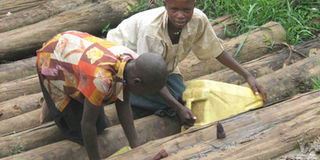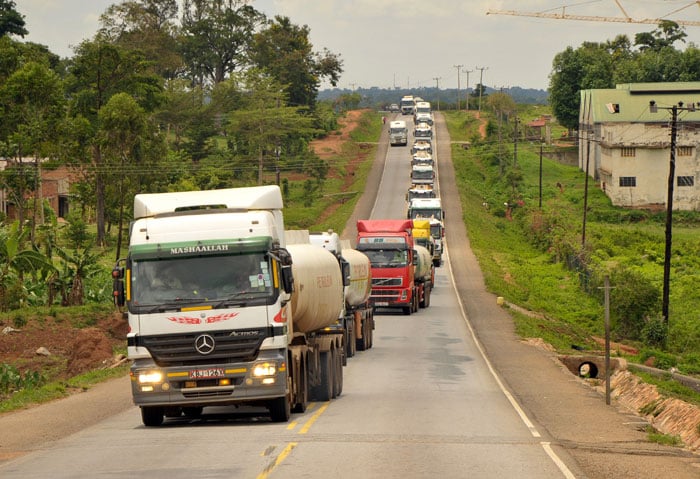Prime
Smelly water threatens livelihoods in lyantonde

Above, children draw water from a natural spring well in another district (Rakai). Lyantonde District does not have such natural sources of water. Below, all the crops touched by the flood water at Kitindo from the swamps dried up. Photos/Michael J Ssali
What you need to know:
Last week, Uganda celebrated World Water Day, but, in Lyatonde like many places in Uganda where water is scarce, only a few households in the district can afford water for domestic and animal use. Even when it rains, most households still live in grass-thatched houses and may not easily tap water from the roofs, let alone being able to buy a small water tank due to poverty.
In the early evening at Kitindo, where the water meets between Lyantonde and Rakai Districts, hundreds of men, women, and children line the roadside drawing water using clay, metallic or plastic containers. It has become the best time for the people from the neighboring villages to draw water, as by that time it has lost some of its pungent smell to the day’s air.
Swamps surround the people living along the shores of Lake Kachera. And their smell carries over to the water supply next to it. It might look clean and clear, but it is not good for washing clothes or for cooking food. Its smell is noticeable in the tea, in the soup, in nearly anything you may cook. It does not lather with soap but it is the water most people here use to bathe, wash their clothes and to clean household items anyway.
Paul Mukasa of Buyanja near Kitindo says despite the water’s poor quality, people there generally consider themselves lucky to have it. “When it dried up at one time we had to go as far as three miles from here to get water from a borehole,” he said.
People by the southern Uganda marshes live in a semi-arid climate and experience acute shortages of water due to long spells of drought. The district has a total of 123 boreholes in various villages but only about 60 per cent of these are functioning.
Residents have gotten used to making do, but the general water scarcity in the district is frustrating everything from economic activity to anti-poverty efforts.
Farming efforts dry up
Kitindo means a bridge of sorts in the local language, but it is not really a bridge. Rather, the gigantic tunnels carry the stream under the road, which connect the two districts. Sometimes during heavy rains, the swamp gets flooded and passage is limited to improvised canoes.
After the rain season has ended and plenty of earth has been added to the road surface, it becomes passable once again. But nearly all the crops touched by the floodwater in the nearby gardens are dead and dry.
Thaddeus Ssebikwate, parish chief of Biwolobo, along the lakeshore, recalls several incidences when farmers tried to use it for irrigation and all their crops dried up. He says the grass from the swamps must never be used for mulching because the crops will all die.
Ericson Kamukama, assistant district water officer, explains: “That grass has too much iron, especially when it is still green. As it dries it interferes with the soil nutrients, reducing them drastically. If the grass must be used at all for garden mulching the farmer must wait until it is thoroughly dry,” he says.
The district’s population of about 120,000 people is mainly pastoralists, estimated to have about 100,000 heads of cattle, and several thousand goats and sheep. But residents suspect even they are being effected.
“Our animals drink the water and they look big and healthy, but I have to tell you the fat content of their meat is very low, something we always hide from cattle traders who normally prefer fat animals,” Ssebikwate confided.
Local activists are saying especially in the looming days of climate change ahead, farming is bound to be very difficult unless more investment is put in water development.
Water fights poverty
Water has been identified by government as a main hurdle to overcome in its Poverty Eradication Action Plan (PEAP). About half of the district’s 14,525 households are female-headed households, and their lack of water has often been blamed for leading women into prostitution in Lyantonde Town. The government, through Naads and Salama Shield Foundation (SSF), an anti-HIV/Aids NGO, among others, has been promoting agriculture by providing animals such as goats and microcredit to local women to discourage prostitution.
SSF actually provides free water drilled from underground and poor households cannot pay for piped water in Lyantonde Town – to offset sexual assaults. “When teenage girls returned home from school they always went to the boreholes to fetch water and they were often taken advantage of by the men who guarded the boreholes,” Kenneth Mugabo, SSF country director explained. “They had to line up for water and often it became dark as they waited which further exposed them to sexual risks.”
Water way out?
The two water officers contended that Rakai District has very few options for procuring water for its people. It has no permanent flowing rivers and Lake Kachera is the only natural water body available.
“The main water provision options are rainwater harvesting and drilling underground water,” Lyantonde District Water Officer, Francis Kiwanuka points out. Rainwater is greatly treasured by the people living around Lake Kachera and nearly every home in the area has at least a small container of it for use when preparing a special dish in the home or to boil tea for a visitor.
Only very few households in the district can afford basic rainwater harvesting system. About half the households still live in poorly constructed grass-thatched houses and may not easily tap water from the roofs, let alone being able to buy a small water tank.
The government has constructed some five valley dams according to Kiwanuka. “That water is supposed to be for the animals but it is difficult to stop the people from using it also” he said. “What we do is to fence the dams in such a way that both animals and people get the water without stepping into it.”
The five valley dams are however, simply not enough. Tractors, excavators, and other hardware have been provided at Lyantonde District headquarters for the few who can afford to hire and fuel them to make valley tanks to trap rain water on their farms. So far about 40 privately owned water tanks have been dug in the district under the arrangement.
Looking back to the solution?
Thieves often dismantle such boreholes and sell the pieces to scrap metal traders or remove taps from the water tanks at the rainwater catchment units. The bolts used to fix them are the same ones used to fix lorry carriers and so in some cases the thieves sell the bolts to mechanics.
Vandalising public water facilities is not uncommon in the district. Kiwanuka says the water department always carries out some sensitisation about maintenance of boreholes, shallow wells and public water tanks before providing them to the communities.
The sensitisation especially involves a village water committee, who are trained to do maintenance and simple repairs on facilities. “But there are always disagreements usually over who should pay for the repair services or for safeguarding the facilities against vandals and thieves. Often the disagreements lead to failure to manage and sustain the water facilities,” Kiwanuka says.
Many years ago when Lyantonde was still part of Rakai District, rainwater roof catchment units were constructed in such places as Binikiro, Nakasozi, and Kitabo. Kiwanuka says these are normally the solution to water scarcity in very hilly areas where boreholes cannot be used to get underground water, or where it is difficult to make shallow wells or any dams. Unfortunately the roof catchment units were poorly constructed and after a short time the tanks could not hold any water. For years they have stood as useless imposing structures in communities yearning for water.
“We have got the needed money now and we are going to work on them again,” Kiwanuka revealed. “In the meantime we are to provide them with plastic tanks as we repair the cement ones.”
Treating the smell not the cause
Kiwanuka says that as much of the papyrus, grass and the living things tend to die and dry up during the dry season, when the rain comes it often rots them, which result in the offensive smell.
There is underground water available too, but it is hidden deep underground and it only comes to the surface with a variety of minerals. By nature, Kiwanuka says the water in the lake is loaded with chemicals sulphates, aluminum, zinc, and others.
Yet the same water is pumped from the lake to Lyantonde Town, where it is used in the entire urban public water system, and it does not smell at all. “In Lyantonde Town we treat it and make it user friendly and entirely safe for human use,” Kiwanuka said.
While Uganda is listed as one of the better countries for having improved access to drinking water since 1995, there is still a rural-urban divide. In a joint monitoring programme report from the World Health Organisation and Unicef, it says 40 per cent of Uganda’s population gained access from 1995 to 2010.
But 14 per cent in rural areas are still using surface water, while only 2 per cent in urban areas, the report says. Meanwhile, sanitation only increased for 16 per cent of the population in the same time frame, and has been highlighted as the next major water governance issue to look out for.




